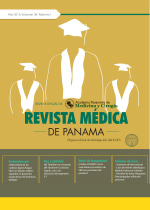Tomografía computada en pacientes con conexión venosa pulmonar anómala, Hospital del Niño
Autores/as
DOI:
https://doi.org/10.37980/im.journal.rmdp.20211835Palabras clave:
defecto cardíaco congénito, conexión venosa pulmonar anómala, tomografía computadaResumen
Introducción: La conexión venosa pulmonar anómala total (CVPAT) es un defecto relativamente poco frecuente, con una prevalencia de 0.8 por cada 10 000 nacimientos vivos, mientras que la forma parcial, tiene una mayor prevalencia, que oscila entre un 0.4 y 0.7% de la población. En Panamá, la CVPAT representa un 9% de los nacimientos con defectos cardíacos. Este estudio tuvo como objetivo evaluar las características por tomografía computada de los niños con este diagnóstico que fueron atendidos entre los años 2010 y 2020 en el Hospital del Niño Dr. José Renán Esquivel. Método: Se realizó un estudio descriptivo, retrospectivo, de corte transversal en la población sometida a tomografía computarizada por cardiopatía congénita en el Hospital del Niño Dr. José Renán Esquivel de la Ciudad de Panamá, en el período comprendido entre enero de 2010 y diciembre de 2020. Se realizaron 615 tomografías computarizadas por malformación cardíaca. De estas, 51 tenían diagnóstico de conexión venosa pulmonar anómala (CVPA) Resultados: Se encontró un predominio de esta patología en el sexo masculino (57.5%). Un 76.2% de los pacientes cursaban con otra malformación cardíaca asociada, siendo la comunicación interauricular (CIA) la más frecuente (54.5%). Los tipos más frecuentes fueron el supracardíaco (50.0%) y el infracardíaco (28.5%). Conclusión: La tomografía computada con contraste endovenoso es un método útil, que permite evaluar con detalle la anatomía cardíaca y de los grandes vasos en pacientes con malformaciones cardíacas y que además brinda información valiosa sobre otras patologías asociadas.
Publicado
Número
Sección
Licencia
Derechos de autor 2021 Infomedic Intl.Derechos autoriales y de reproducibilidad. La Revista Médica de Panama es un ente académico, sin fines de lucro, que forma parte de la Academia Panameña de Medicina y Cirugía. Sus publicaciones son de tipo acceso gratuito de su contenido para uso individual y académico, sin restricción. Los derechos autoriales de cada artículo son retenidos por sus autores. Al Publicar en la Revista, el autor otorga Licencia permanente, exclusiva, e irrevocable a la Sociedad para la edición del manuscrito, y otorga a la empresa editorial, Infomedic International Licencia de uso de distribución, indexación y comercial exclusiva, permanente e irrevocable de su contenido y para la generación de productos y servicios derivados del mismo. En caso que el autor obtenga la licencia CC BY, el artículo y sus derivados son de libre acceso y distribución.






